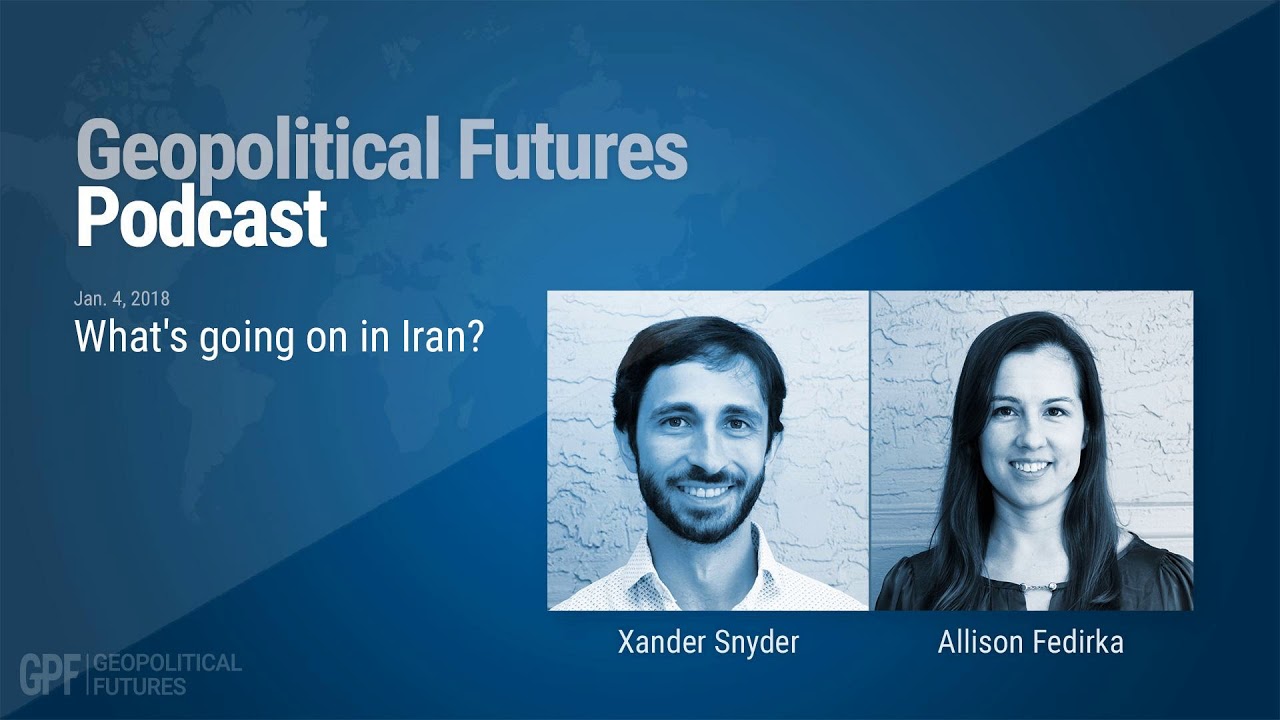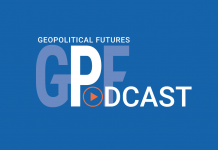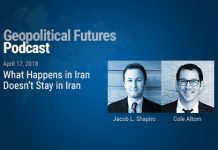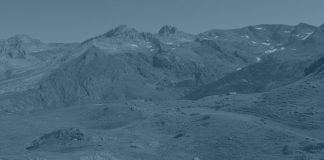Allison Fedirka: Hello and welcome to Geopolitical Futures’ podcast. I’m Allison Fedirka and this week we are talking with senior analyst Xander Snyder. And basically what we’re going to do today is address something that I’m pretty sure all of our listeners are well aware of, which are the current protests underway in Iran. They have been making headlines for almost a week and there’s a lot of different moving pieces and sometimes we can lose track of all of the different issues that are going on, especially when you have such media-friendly events of protesters and yelling and arrests and things like that.
So Xander if we could start, could you just walk us through and provide some clarity on just when did these protests start and how have they evolved over the past few days into what we see now?
Xander Snyder: Sure. Well the protests started on Dec. 28, it was a Thursday of last week and they began in the second biggest city in Iran which is called Mashhad which is sort of in the north. And they really caught a lot of people off guard at the time. No one or not many were expecting a new set of you know mass mobilizations to occur. And then they spread quite quickly.
So they started in Mashhad and were in maybe four other cities and towns that day. And then the next day they spread to a number of other cities and towns including Qom. Day three saw the protests spread to even more cities, I think like 15 or 20 different cities and towns saw protests that day. And they’re still going on although as of the date of the recording of this podcast, which is Thursday of this week, which is the 4th, it does seem like we’re getting at least the beginning of some indications that they’re beginning to die down or at least be quelled to some degree.
Now the reason that is important to point out the geographic diversity of these protests is to draw a comparison with the mass uprising that we saw in 2009, it was coined the Green Revolution. And that’s because the Green Revolution really mainly occurred in the capital of Tehran. It was mainly comprised of students and younger individuals and it really began as a political movement. By contrast, these protests appear to begin mainly on economic grounds.
It was not only students in a specific demographic, we saw lots of different middle and lower-class individuals protesting and they were protesting not because they were dissatisfied with the lack of representation in their government. They were dissatisfied because it seemed like they were struggling buying food. And that strikes a lot closer to home for that particular demographic. The other thing that’s worth noticing with the geographic spread is there is more of a geographic spread in what started this protest in the late ‘70s which ultimately lead to the 1979 revolution.
So people who have been drawing contrasts to that, there are clearly some differences and maybe we’ll touch on that later in this episode. Although it’s hard to cover everything in a thirty-minute podcast. So while we might not be able to do a deep dive on all of the nitty gritty details here by all means stay tuned next week because our Deep Dive will cover those.
AF: Fantastic and we’re looking forward to that. So what we can cover now is to dive a little bit deeper into what people have said of the cause of these protests which are economic factors. Iran has been under sanctions, sanctions have been lifted and Iran’s economy under sanctions suffered immensely. In that sense, the sanctions were effective.
Now in a post-sanction world, there’s still a lot of recovery that Iran’s economy needs to do at this point in time. So the idea that there is widespread discontent among the population over economic factors is not hard to believe by any means. Unemployment has remained persistently above 12 percent and has hovered in that area ever since 2016, January of 2016. So we’re looking at almost two full years now of unemployment at 12 percent. And they have a saying in Argentina which is inflation hurts but unemployment kills. And in a certain respect that would apply here as well. If you don’t have a job, if you don’t have a source of income, you can only go so long before you start to run into some problems.
Another issue is inflation, that has been largely circulated and that is a problem in Iran. There is the psychological threshold of 10 percent that’s being cited in Iran as being a problematic level of inflation. And this is primarily because Rouhani promised that he would keep inflation in the single digits. And the reason inflation has become so much of a trigger for the current population right now in Iran is because under sanctions they got quite high. They got as high as 30 percent in 2012 and 2013 and this was during the peak of sanctions.
So all of the people in Iran right now will remember four or five years ago. And while 10 percent is obviously lower than 30 percent, there is still this concern that there was the promise of the economy getting better, inflation is starting to creep up again. Are they actually going to see better economic conditions in their country or not? And that leads to several other factors that can also occur such as speculative pricing. We haven’t really seen too many of those reports coming out of Iran right now. But that’s always something to keep in mind as well. Because once people start to worry about inflation, that is something that can easily start to occur.
And Xander also mentioned the other main issue is the question of food. So inflation applies in general to any goods. But when they start to affect food prices, that can be particularly problematic for a population. So some of the basic goods that we’ve seen have been cited in the press as going up as much as 40 percent in the last week of December. So obviously if you have a family to feed, if there’s basic food items that are going up 40 percent, you are going to react.
It’s important to understand a little bit why this is happening so the main item that has been making headlines for example are eggs. And that is because the question isn’t so much is there a shortage of food? But rather the production of feed grain. Iran has to import a lot of this, it imports about 80 percent of this. And that is what is necessary to raise the chickens, to get the eggs and things like that. And the problem is not that there isn’t grain, there’s grain in the world. Iran can buy it.
The problem is the Iranian banking system and the high NPLs and the lack of regulation and the informality and the many broader issues that the banks need to resolve after they have been isolated from the international system for a few years. And that means that trading houses and brokerage firms and other European banks and American banks may not be so willing at this point to engage in major financial transactions with Iran because their banking system is not seen as reliable or meeting international standards.
So when we start to talk about unemployment, inflation, it really starts to snowball rather quickly because it not only goes in one direction of affecting the daily life of people in Iran with can they buy enough food for themselves? But it also snowballs into bigger picture things such as the banking crisis, I won’t say crisis but the banking regulation issues that a local person can’t solve and falls primarily to the responsibility of the government. And in the case of Iran, Xander can elaborate a little bit more about how where they’ve actually seen some economic growth going on right now and why even though there has been some economic growth, it hasn’t actually affected the general population.
XS: That’s right so after the sanctions were lifted with for the United States. By the way that doesn’t mean all sanctions, it just means the sanctions that are related to the agreement the JCPOA. Iran’s economy did see some growth. I think it was high three percent over the last year. Don’t quote me on that. But it was positive growth, it was slight but it was positive.
And President Rouhani basically banked his second term on alleviating the economic distresses of the common people. And a lot of that really boiled down to this agreement with the U.S., the JCPOA, thinking that ah well, we lift these sanctions and all this money and all this investment capital will flow in and the new investment will help create those jobs that we so desperately need. And the problem is that hasn’t really happened. Unemployment has persisted and the gains that have been made in terms of economic growth resulted primarily from increased oil sales. And the profits from those increased oil sales have not really been spread around as much as Rouhani was hoping.
Now there’s an element to this which has to do with the IRGC, basically the military organization that’s responsible for safeguarding the security of the regime and that is that the IRGC is actually deeply involved in the economic system of Iran. It’s very hard to get specifics on this but one estimate is that they’re either directly or indirectly responsible for something like a $100 billion worth of assets so and that includes some of the state oil operation. So as this new money has flowed in, the security apparatus responsible for defending the state has been doing quite well. And actually, one of the complaints amongst the protestors, one of the economic complaints is, hey you guys are doing great but we haven’t really seen much of this.
Now as when we look at protests and the safety of a particular regime and we’ve been doing this in Venezuela too, one of the things that we really try to keep our eye on is defection of security forces because once the guys who actually shoot the guns to defend the existing regime start putting the guns down, that’s when the regime starts facing problems. And from what we can tell right now, there’s really no reason to believe that the IRGC or the rest of the intelligence and security apparatus is really incentivized at all to turn on the government. And this plays into a little bit about how we’re thinking of the threat to the regime generally.
But before I get onto that, I want to touch on one more issue on the economic aspect which is inflation and the banking system. At GPF, we spend a lot of time talking about constraints and how economic factors influence political factors and how they’re really not separated but one in the same as our defense issues.
Now Allison, you mentioned that inflation in Iran was much higher several years ago, 40 percent in that range and now it’s much lower. Obviously certain staple goods like eggs, like poultry, have seen rapid increases due to increased feedstock prices and also I read that they culled something like 15 million chickens due to fear from avian flu. Those are not necessarily deep geopolitical issues but they’re symptoms of the vulnerability of the system if something like that can set off such insecurity. But anyways, one of the ways that inflation was gotten under control was by raising interest rates and a tightening monetary policy right would be the economic jargon.
So in the current situation if a government would try to increase jobs, you know there’s a couple of go-to options at your disposal. One would be looser monetary policy, lowering interest rates. The problem is because the Iranian government is faced with this constant threat from inflation, looser monetary policy isn’t really an option for them because if they start printing money then the cost of Iran’s currency is just going to decline making imports including feedstock even more expensive. So while that could be one way to encourage investment, that’s not really an option right now.
AF: Those are some of the causes that we have been looking at as to why we would have a general disgruntled population in Iran and there are two notable features that have flowed from this. The first is that the rhetoric that of the protests has shifted over the past few days to not just focus on economic issues but have also started manifesting itself in general political discontent where we now see some protesters having calls for regime change for removal of leaders. We’ve also seen the government promoting pro-government rallies to show that there’s a portion of the population now that supports the government’s role.
So this has started to expand not just from an economic standpoint but also one now that enters the political realm for Iran. And in that sense, we’re also looking at the government response. In terms of how to fix the economy, that’s going to take some time. The government has come out and said we support peaceful protests, we’re ok you need to do this within the legal terms that we have established. That’s how they initially started to address this and since then it’s involved into a variety of different actions that the government has taken.
Xander, can you walk us through the different moves that the government had done so far and what we can glean from them in terms of how it looks for their control over the situation going on, on the ground?
XS: Yeah, like you said when the protests started, they were really focused on economic issues, that put the government at least initially in sort of a difficult place because it is much easier for the clerical regime to crack down on political dissent. It’s a little bit harder if people are out there saying we can’t feed ourselves. So when the protests first broke out and we’re still struggling to get exact figures by the way. The numbers coming out in different reports range from thousands to tens of thousands in that language.
AF: And that’s nationwide.
XS: Yeah exactly. And in some towns and villages, you know some of these villages are quite small, you know like 10, 20, 30,000 people, it might be a couple hundred. But that’s kind of the best we’re able to do right now. When the protests started, the government really took a soft approach. They deployed police forces but really it was more to kind of monitor the situation. They didn’t send out the special units that they did in 2009 to really start beating down and violently suppressing dissent.
However, as protest tenor changed from economic to political as you mentioned, that’s when the government starts to take a slightly heavier hand. Now we haven’t seen violent suppression on the magnitude as we did in 2009 when there were on the order of a million people protesting, in part because the protests this time are much smaller. The government did at first warn, I mean Rouhani came out and said people have a legitimate right to protest about economic issues. But if this becomes political and you can couch that in language of threatening security and all of that. He basically said if it becomes political, we’re going to do something and they did.
And in the interim between actually deploying some of the law enforcement agencies to put down the dissent, it seems at least as of now that the government somewhat effectively shut off access to different messaging services including Telegram and I guess Instagram to the extent that’s a messaging service, it’s more of a social media platform. And since at least right now it kind of appears that social media platforms and these messaging apps really helped drive the what seem like spontaneous protests at first, it seems like the government cracked down on that flow of communication, was somewhat effective.
Now that’s a little hard to tell because we’re getting fewer details now on the size and the developments of the protest in part because we don’t have data flowing from Instagram and Telegram because the government shut it down. So you know, there could be a couple of causal elements that confound the conclusion that you draw. Now as far as casualties and arrests go, the number we’ve been seeing so far has been 21 people have been killed nationwide. And that has actually stabilized as far as we could tell over the last two days or so. That might be an indication that the protests are in fact dying down as the government claims. But again, not a lot of new data and we’ve seen about a thousand people arrested nationwide right now.
AF: And the other thing that we should be keeping in mind with these protests is the government repression is an obvious factor in how long these will be able to continue. A couple of other things to keep in mind are the mindset of the people who are protesting which sounds perhaps a little too much on the individual level but when we think about social unrest in general, there are a few things that will go through the mind of people going out to protest.
First of all, somebody had to feel that it was acceptable or safe enough that their life would not necessarily be threatened perhaps if they went out to protest. Someone felt empowered enough to be able to go out and do this, obviously several thousands of people felt empowered enough to go out and do this. That’s one threshold, crossing that first threshold to just get out and protest in the first place.
The challenge after this is to sustain this level of protest. So when we look at social protests that become a fundamental problem for a government, that could either force changes in how the government is run or who is in power or enact major shifts in economic policy or what have you, the degree and the way in which they respond to the protesters will ultimately be responsive to the pressure that they’re feeling from the public.
So if the government is effective in suppressing the public that is good for the here and now, but bear in mind that sustaining protests nationwide, growing protests from their current size to a larger size, this will take a degree of organization. And it will also take a degree of, for lack of a better phrase, staying power. Sustaining large-scale nationwide protests is an extremely difficult thing to do. It’s not necessarily impossible. But the longer that these go on as they die out over time, the safer if you will the government will be in that, the threat of these people will die out and perhaps they will resurge later on in time.
But in terms of thinking at this particular event, this particular time frame, if you don’t act soon, if you don’t act fast and capitalize on your momentum, that momentum will eventually start to die out and then you need to recover it if you want to pursue this same path at a future date. So that is just something else to keep in mind from the protesters’ point of view for this as opposed to the government crackdown which is let’s squash this, let’s stop this and keep control as much as possible.
XS: So the question on a lot of people’s minds since these protest began has been of course the threat to the regime, is the regime really threatened by these protests? And as I sort of hinted at earlier, the best answer we have right now is probably not, in part because of despite the more blended demographic in terms of the middle and lower classes being involved which is maybe more of an indication of you know a different type of hurt than was maybe expressed in 2009.
It really still seems that the security forces and intelligence services responsible for defending the clerical regime are firmly still in their pockets, both financially and ideologically incentivize to protect the institutions as they currently exist. You know if it gets to the point that where they’re killing a number of citizens, sometimes that overrides the financial considerations but we’re really not there yet. So we don’t see these protests as posing an existential threat to the regime yet.
But that doesn’t mean that the regime won’t feel forced to make some concessions and some domestic concessions in terms of refocusing their policy priorities. But it doesn’t seem like the supreme leader is going to be toppled and thrown out of his position next week.
AF: So that’s how Iran is going to react let’s say to the domestic audience that it has. Is there any reason to believe or in what way would these protests affect Iran’s behavior at the international level? We’ve seen it very active in Iraq and with a lot of the ISIS campaigns or anti-ISIS campaigns that have been going in the region. We’ve seen it posturing with other regional players like Turkey and Israel and antagonizing Saudi Arabia. Does this change anything for Iran the country in the Middle East as opposed to just the domestic questions that we’ve been looking at here today?
XS: I think the best answer I have right now unfortunately is possibly. I am still trying to get my head around this specifics of that. But this is how I’m thinking about it. I mentioned a moment ago about the constraint that the regime faces in terms of not really being able to lower interest rates because that could actually exacerbate the unrest because it would make things more expensive due to inflation. That kind of leaves fiscal policy in terms of trying to fix the unemployment issue.
And one of the things that the regime desperately needs is investment. Investment can come from home or it can come from abroad. The banking system as you mentioned is kind of tapped out, there’s a lot of non-performing loans. They’re kind of stretched thin in terms of credit extended. I think their reserves are on the low side in terms of maintaining a certain degree of stability in the economic system.
So there’s not a ton of private domestic capital that can be extended. And there’s still fear that from the international arena that the situation might not be sufficiently stabilized in terms of Iran reopening to the rest of the world to merit large-scale investment. So the only other place this could possibly come from would be the government budget and when the 2018 budget was unveiled fairly recently, a lot of people were very frustrated because it looked like it was going to entail further austerity measures, which would have not have made the situation better.
So the last option is reallocating some money in this budget for domestic, public investment. Now how much would be required to fix the problem versus how much would is available, I don’t have the answer to that yet. And where would that money come from relative to where it is currently slated for, you know in terms of maintaining Iran’s military presence throughout the region, it’s hard to tell.
But you could make a case that money might have to come out of parts of the military, parts of the international military side in order to fund the domestic investment to help spur job growth. I certainly don’t think what you’re going to see is money coming out of the budget pulled from the IRGC, because again that’s really what defends the regime. So I think you know that would be the very last thing to go if something were ever to happen to the regime.
But you know in summary, it seems like you could make the case that the Iranian government might be forced to divert some funds from international intervention to the domestic, economic arena.
AF: Well it’s definitely a lot to digest and look for and this of course an unfolding situation, for example right now there’s no clear leader of the protests. Will we see one emerge? Will we not? Any type of government responses beyond just the domestic security crackdown but in terms of economic plans to address some of these issues are all question marks at this point in time. And we’ll see how those unfold as time goes on.
In the meantime, I want to say thank you to Xander for joining us with our talk today. And encourage everyone to check back in on our website http://geopoliticalfutures.com Thursday, Jan. 11 and that is when the Deep Dive that he said he is working on right now will be coming out. And I encourage anyone who’s interested in hearing more about Iran and the geopolitical foundations of the country and the nuts and bolts of its behavior as a country if you will, that will definitely shed light on why the government is behaving the way it is now, why society is behaving the way it is now.
And how those two interact as a product of their environment and their geopolitical upbringing in Iran will be really enlightening I think for a lot of people. So I encourage you to check it out and Xander thanks again.
XS: Thank you Allison.







 The Geopolitics of the American President
The Geopolitics of the American President